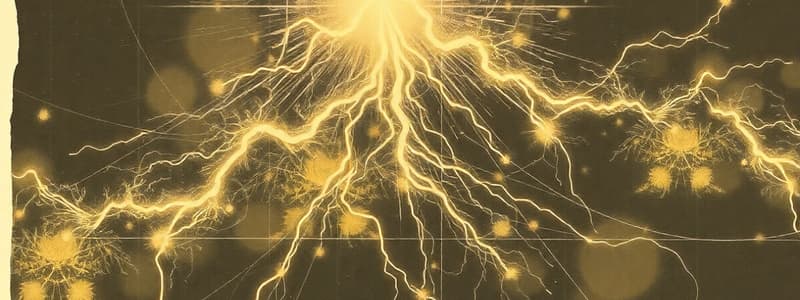Podcast
Questions and Answers
Match the terms related to electrostatics with their descriptions:
Match the terms related to electrostatics with their descriptions:
Coulomb's Law = Quantifies the force between two point charges. Electric Field = The region around a charge where another charge experiences a force. Electric Potential Energy = Energy stored in a system due to electric forces. Electrostatics = Deals with electric charges at rest.
Match the applications of electrostatics with their respective processes:
Match the applications of electrostatics with their respective processes:
Photocopiers = Utilize electrostatic attraction to transfer toner onto paper. Electrostatic Painting = Employs charged particles to evenly coat surfaces. Air Purifiers = Remove particles by charging and collecting them on charged plates. Van de Graaff Generator = Accumulates electric charge on a hollow metal globe.
Match the factors affecting electrostatic force with their effects, according to Coulomb's Law:
Match the factors affecting electrostatic force with their effects, according to Coulomb's Law:
Increase in Charge Magnitude = Results in a proportional increase in electrostatic force. Increase in Distance = Causes a decrease in electrostatic force, following an inverse square relationship. Dielectric Constant = Modifies the electrostatic force between charges in a medium. Charge Polarity = Determines whether the force is attractive or repulsive.
Match the concepts of electric fields with their properties:
Match the concepts of electric fields with their properties:
Match the concepts related to electric potential energy with their formulas or descriptions:
Match the concepts related to electric potential energy with their formulas or descriptions:
Match the scenarios with the relevant concepts of electrostatics:
Match the scenarios with the relevant concepts of electrostatics:
Match the parameters with their units used in electrostatics:
Match the parameters with their units used in electrostatics:
Match the behaviors of charges in conductors and insulators:
Match the behaviors of charges in conductors and insulators:
Match the relationships described by Coulomb's Law under varying conditions:
Match the relationships described by Coulomb's Law under varying conditions:
Match the effects of electric fields on different types of materials:
Match the effects of electric fields on different types of materials:
Flashcards
Electrostatics
Electrostatics
Phenomenon involving stationary electric charges.
Coulomb's Law
Coulomb's Law
Describes the force between two point charges; directly proportional to the product of the magnitudes of the charges and inversely proportional to the square of the distance between them.
Electric Field
Electric Field
The region around an electric charge where another charge experiences a force.
Electric Potential Energy
Electric Potential Energy
Signup and view all the flashcards
Electrostatic Applications
Electrostatic Applications
Signup and view all the flashcards
Study Notes
- ไฟฟ้าสถิตเกี่ยวข้องกับประจุไฟฟ้าที่อยู่กับที่
- กฎของคูลอมบ์อธิบายแรงระหว่างประจุไฟฟ้าสองจุด; แรงแปรผันตรงกับผลคูณของขนาดประจุและแปรผกผันกับกำลังสองของระยะห่าง
- สนามไฟฟ้าคือบริเวณรอบประจุไฟฟ้าที่ประจุอื่นได้รับแรง
- พลังงานศักย์ไฟฟ้าเป็นพลังงานที่สะสมในระบบเนื่องจากแรงทางไฟฟ้า
- ไฟฟ้าสถิตมีการประยุกต์ใช้หลายด้าน เช่น เครื่องถ่ายเอกสาร เครื่องพ่นสี และเครื่องกรองอากาศ
Studying That Suits You
Use AI to generate personalized quizzes and flashcards to suit your learning preferences.




